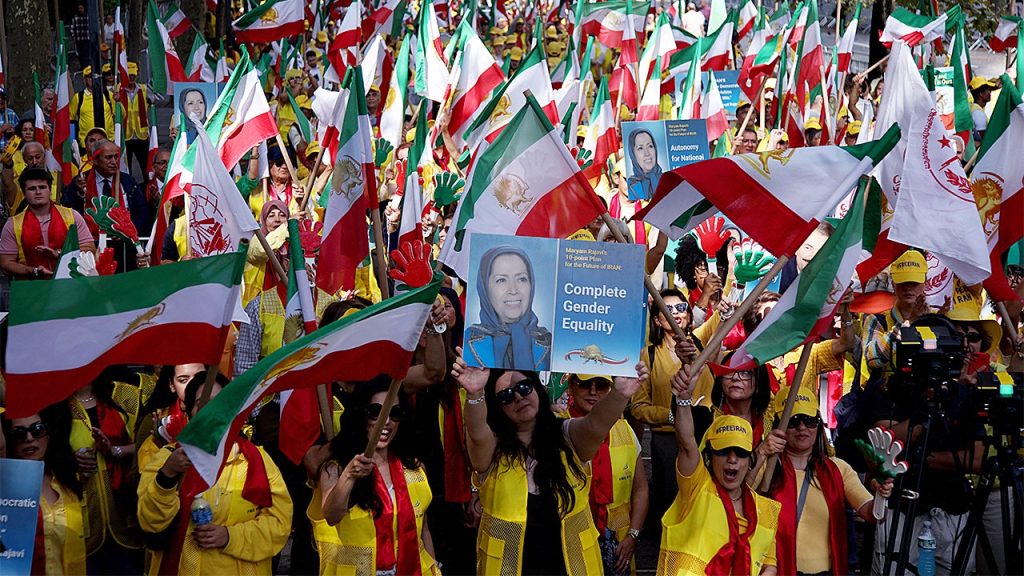Iranian President’s UN Address Met with Protests and Criticism
Tensions Rise as Pezeshkian Speaks While Thousands Demonstrate Outside
In a striking display of contrasting narratives, Iranian President Masoud Pezeshkian’s first address to the United Nations General Assembly was met with significant opposition both inside and outside the chamber. Speaking to world leaders, Pezeshkian characterized recent U.S. airstrikes on Iranian nuclear facilities as a “grave betrayal of diplomacy” and a violation of international law. He claimed the attacks had killed civilians, scientists, and intellectuals while maintaining Iran’s longstanding position that it “never sought weapons of mass destruction.” His speech attempted to position Iran as a victim of Western aggression, particularly from the United States and Israel, whom he accused of “savage aggression” against his country. Meanwhile, just outside the UN building, thousands of Iranian Americans and dissidents gathered in protest, creating a powerful counterpoint to the official narrative being presented within.
The protesters outside represented a diverse coalition of Iranian expatriates who had traveled from across the United States to make their voices heard. Mitra Samani, a former political prisoner who spent four years in Tehran’s notorious Evin Prison during the early 1980s, journeyed from Los Angeles to participate in the demonstration. “We are here to say that the seat in the U.N. doesn’t belong to those murderous regime agents. It belongs to the people of Iran and their representatives,” she told reporters, identifying the National Council of Resistance of Iran as the legitimate voice of the Iranian people. Samani’s personal commitment to the cause was evident as she explained, “I promised myself when I was released from that dungeon that I would be the voice of my friends that I lost. That’s why I’m here every year.” Her testimony highlighted the deeply personal nature of the protests for many participants, who view their activism as a moral obligation to those who have suffered under the current Iranian regime.
The scale of the demonstration was significant, with Nasser Sharif, chair of the Iranian American Community of California, noting that thousands of protesters had come from forty different states to participate. The protesters’ message was clear: they support the overthrow of the current Iranian regime by the Iranian people themselves, advocating for “a free, secular, democratic republic in Iran.” Many carried Iranian flags and placards declaring that Pezeshkian does not represent the true will of the Iranian people. Alireza Jafarzadeh, deputy director of the U.S. office of the National Council of Resistance of Iran, described the rally as “an impressive show of force” and emphasized that the protesters supported regime change through internal Iranian action, “with no need for foreign boots on the ground or providing money and arms.” The demonstrators called on the U.S. administration to increase pressure on the Iranian regime and stand with the Iranian people’s desire for democratic change.
Much of the criticism from protesters and analysts alike centered on the United Nations itself for providing a platform to representatives of a government with a well-documented record of human rights abuses. Jafarzadeh expressed outrage at this apparent contradiction, stating, “It is appalling to see the world’s leading executioner play any role in any U.N. body dealing with human rights. It is like appointing a serial killer as a judge to rule on his own murders.” Richard Goldberg, senior advisor at the Foundation for Defense of Democracies, offered a similarly scathing assessment, comparing the UN to the Netflix show “Stranger Things” – a place where reality is inverted, allowing “a tyrannical, women-oppressing, nuclear-weapons-pursuing regime” to serve in leadership positions on human rights, women’s rights, and nuclear nonproliferation organizations. This criticism highlighted what many view as a fundamental credibility problem for international institutions that claim to uphold universal values while accommodating regimes that systematically violate them.
Experts also noted the gap between Iran’s diplomatic rhetoric and domestic realities. Behnam Ben Taleblu, senior director of the Foundation for Defense of Democracies’ Iran program, described Pezeshkian’s speech as “short but not sweet” and pointed out the irony of Iran holding leadership roles in international organizations: “Can there be something more ironic than the Islamic Republic of Iran, which has long been a proliferator and seeking a nuclear weapon, being a vice president of the IAEA?” He further observed that Pezeshkian’s remarks were overshadowed by recent statements from Supreme Leader Ayatollah Ali Khamenei, who had been unequivocal about rejecting negotiations with America. This disconnect between the diplomatic face presented at the UN and the hardline positions taken by Iran’s ultimate authority underscores the complex, multi-layered nature of engaging with the Iranian regime.
The diplomatic tensions were further heightened when, following statements from U.S. President Donald Trump’s Middle East envoy Steve Witkoff about Washington’s “desire” to find a permanent solution to disputes with Iran through talks, Iran’s Foreign Ministry quickly dismissed these overtures. Ministry spokesperson Esmaeil Baghaei bluntly stated that “America’s claim of a desire for diplomacy is nothing but deception and blatant contradiction,” arguing that “one cannot simultaneously bomb a country while engaging in diplomatic negotiations and speak of diplomacy.” This exchange encapsulates the deep mistrust and seemingly intractable positions that continue to characterize U.S.-Iran relations, even as both sides periodically signal interest in diplomatic engagement. As Pezeshkian returns home and protesters disperse, the fundamental questions about Iran’s future governance, its nuclear ambitions, and its place in the international community remain unresolved, with competing visions continuing to clash both within Iran and on the global stage.


